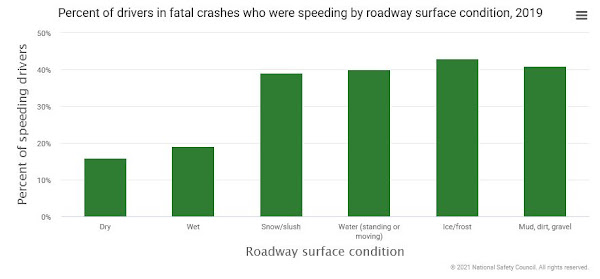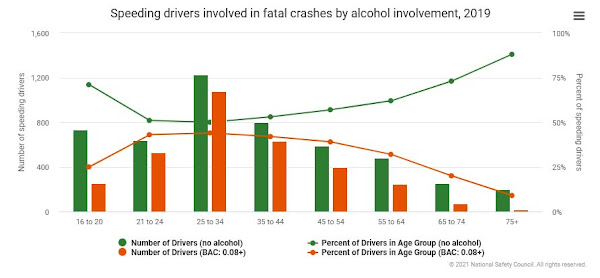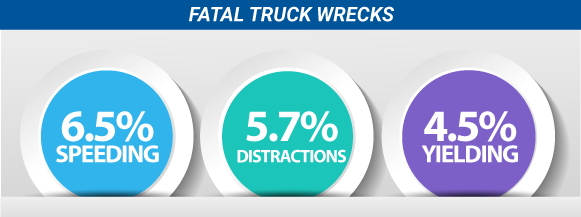Excessive Speed was a factor in 26% of all traffic fatalities in 2019. 23 people per day were tragically killed in a motor vehicle accident caused by excessive speeding. A crash is considered speeding-related if the driver was charged with a speeding-related offense or if racing, driving too fast for conditions, or exceeding the posted speed limit was indicated as a contributing factor in the crash.
Speeding reduces the reaction time the driver has to engage during a dangerous situation in order to avoid a crash, increases vehicle stopping distance, and reduces the ability of road safety structures (such as guardrails, impact attenuators, crash cushions, median dividers, and concrete barriers) to protect vehicle occupants in a crash.
Risk of crashes and injuries:
• Speeding increases the distance a vehicle and the driver’s response time to react to an emergency
• Speeding increases the distance needed to stop a vehicle
• Speeding increases the energy produced during the impact of a crash
Impact speed increases from 40 to 60 mph, the energy that needs to be controlled increases by 125%. At high speeds, the force of impact in a crash can be so severe that the structure of the vehicle cannot protect the driver and its passengers. The vehicle collapses into the occupant compartment, and likewise, airbags and safety belts cannot keep the forces on occupants safe.
The severe injuries typically seen in car crashes are fractures, head and traumatic brain injury (TBI), spinal cord injury, and crushing injuries that cause internal organ damage. These injuries worsen as the speed of one or more vehicles in the crash increases. As speed increases, so does the likelihood of death in a car accident. Speeding Demographics
The amount of speed-related crashes to fatal crashes in 2019 decreased as the age of the driver increased. The number of female drivers who were speeding is smaller than male drivers across all age groups. Young male drivers in the 16-20 and 21-24 year age groups were the most likely to be speeding at the time of fatal crashes. In 2019, 30% of male drivers in these age groups involved in fatal crashes were speeding. In comparison, 17% of female drivers age 16 to 20 and 18% age 21 to 24 were in fatal car accidents involving excessive speeding. Accidents happen more often on local roads than interstates, freeways, and expressways. Interstate and non-interstate freeway and expressway fatal speeding accidents make up just 17% of the total. Non-interstate local, principal and minor arterials account for 63 percent of speed related traffic crash fatalities.
Road Conditions
Speeding becomes an extremely important factor for drivers involved in fatal crashes as roadway surface conditions become compromised.
Speeding on Dangerous Road Conditions:
• 16% of drivers on dry roads
• 19% on wet roads
• 39% on roads with snow or slush
• 40% on roads with moving or standing water
• 41% on roads with mud, dirt, or gravel
• 43% on roads with ice or frost
Driving Under the Influence
Speeding and alcohol impairment often go hand-in-hand. 25% of speeding drivers under age 21 involved in fatal crashes are alcohol impaired (BAC = 0.08+ g/dL). Over 40% in the 21 to 44 age groups are impaired. The percent of alcohol-impaired drivers falls sharply to 32% among 55- to 64-year-old drivers and continues to decline as the driver age increases. Fatal Truck Wrecks
Excessive speeding is a leading cause of commercial truck wrecks in the United States. A speeding 18-wheeler has so much momentum that the resulting accident is very likely to result in severe injury or death. Commercial trucks accounted for 9.8 percent of the vehicles in fatal crashes.
If found guilty of a fatal accident caused by excessive speeding, a Commercial Driver License (CDL) holder may have their CDL disqualified for a specified amount of time if convicted of serious violations.
Excessive speeding violations can result in a 60-120 day CDL revocation. Exceeding the speed limit by 15 or more miles per hour in a Commercial Motor Vehicle (CMV) is considered a serious violation in all states. Driving negligently and causing a CMV-related fatality is considered a major violation. Major violations will result in a lifetime disqualification of a CDL.
Texas does not allow CDL holders to dismiss their ticket through defensive driving or a deferred adjudication program. With this violation the CDL holder may not be rehired by their employer or be able to find work elsewhere.
The Dallas Truck Accident Lawyers of Miller Weisbrod serve the needs of truck accident and injury victims in Texas and nationwide. Our dedicated investigative legal team is ready to gather the evidence about the cause of your accident.
Traffic Fatalities
From 2012 to 2020, 7,413 traffic fatalities were linked to excessive speed in Texas. This accounts for 31 percent of all speed-related traffic fatalities in Texas. Some cities accounted for a large portion of these deaths. These cities ranked as the five most dangerous cities in Texas, with a population of 250,000 or greater, for speeding fatalities. These include; Dallas, San Antonio, Fort Worth, Lubbock and Corpus Christi.
DALLAS
4.67 annual speeding fatalities per 100,000 residents
There were 377 speeding-related traffic fatalities from 2012 to 2017 — the highest number of deaths of any city in Texas. Dallas drivers are almost 50% more likely to be in a fatal speeding accident than drivers in Fort Worth.
SAN ANTONIO
3.68 annual speeding fatalities per 100,000 residents
There are an average of 56 speeding fatalities per year, which, when adjusting for population, is 35% greater than the average across similarly sized cities. San Antonio’s speeding fatality rate is 72% higher than that of Austin.
FORT WORTH
3.13 annual speeding fatalities per 100,000 residents
Fort Worth is one of the most dangerous cities in Texas for speeding, though residents can find some consolation in the fact that they are significantly safer than drivers in Dallas.
LUBBOCK
3.06 annual speeding fatalities per 100,000 residents
The northwestern Texas city of Lubbock was the site of 47 speeding-related traffic fatalities from 2012 to 2017, which was enough for it to rank as the fourth most dangerous in the state. This city's speeding annual fatality rate of 3.06 per 100,000 residents is 12% higher than the average across all of the cities in Texas with a population of at least 250,000.
CORPUS CHRISTI
2.65 annual speeding fatalities per 100,000 residents
There were 52 fatalities that resulted from speeding-related traffic accidents from 2012 to 2017. This is more than double the number of deaths that occurred in Laredo.
CONTACT MILLER WEISBROD
If you or your loved one were injured in a car accident that was caused by another driver’s negligence, you may be able to recover financial compensation for your injuries. To help determine whether you may be able to file a claim against the other driver, contact the Dallas Car Accident Lawyers of Miller Weisbrod to discuss your accident.
We offer aggressive and experienced representation to victims of injuries and their families caused by a truck or car accident in all Texas counties. For more information, we invite you to contact our main offices in Dallas at 214.987.0005 for a free consultation with our experienced personal injury trial lawyers. If you are calling from anywhere else in Texas, please call us toll free at 888.987.0005. You may also fill out the form on this page in order to receive a free case evaluation.













0 comments:
Post a Comment
Note: Only a member of this blog may post a comment.